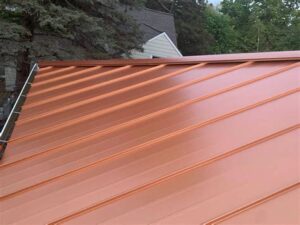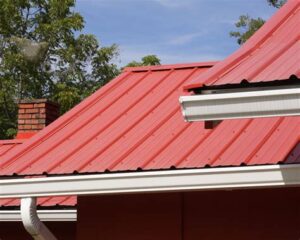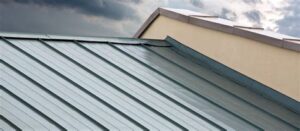When it comes to ensuring the longevity and efficiency of your metal roof, understanding venting maintenance is crucial. Proper roof venting not only enhances the durability of your roofing system but also promotes energy efficiency in your home. This article explores everything you need to know about metal roof venting maintenance, from the essential tools required to a detailed step-by-step guide for inspecting your vents. We’ll also identify common issues that may arise and provide effective solutions to keep your roof in top condition. Regular maintenance not only prevents significant problems down the line but also reaps numerous benefits. Whether you’re a homeowner or a contractor, this comprehensive guide will equip you with the knowledge needed to maintain a well-ventilated metal roof. Let’s dive in!
Understanding Metal Roof Venting: Everything You Need To Know
Metal roof venting is a crucial aspect of maintaining the integrity and longevity of your roofing system. Proper venting helps to regulate temperature and moisture levels within your attic space, preventing condensation and mold growth that could compromise the structure of your home.
There are various types of metal roof vents, including static vents, turbine vents, and powered vents, each designed to improve air circulation in distinct ways. Understanding how these vents work is essential for effective maintenance.
One of the key components of a well-ventilated roof is the balance between intake and exhaust vents. Everything You need to know about this balance is that it allows for optimal airflow, helping to expel hot air during the summer months and reducing energy costs associated with heating and cooling.
Additionally, the placement of vents is vital. Ideally, vents should be installed near the ridges for exhaust and closer to the eaves for intake. When installed correctly, these systems work together to create a healthy airflow, ensuring that warm air escapes and cooler air is drawn in.
Regular inspections and maintenance of your metal roof venting system are necessary to ensure they are free from debris and functioning correctly. It is essential to check for any damages or blockages and address them promptly to maintain the system’s efficiency.
Understanding metal roof venting involves recognizing its components, how they contribute to your roofing system’s performance, and the importance of consistent maintenance practices. By keeping these factors in mind, you can ensure your roof remains in excellent condition for years to come.
Essential Tools Required For Effective Roof Venting Maintenance
When it comes to maintaining metal roof venting systems, having the right tools is essential for effective inspections and repairs. Below is a list of indispensable tools that will aid you in ensuring your metal roof venting operates optimally:
| Tool | Description |
|---|---|
| Ladder | A sturdy ladder is crucial for accessing high areas of your roof safely. |
| Safety Gear | Includes items such as gloves, goggles, and a harness to ensure your safety while working on the roof. |
| Inspecting Camera | A good-quality camera allows for detailed inspections of hard-to-reach areas, documenting any potential issues. |
| Flashlight | Useful for inspecting dark areas under the roof, ensuring you can see potential leaks or blockages. |
| Caulking Gun | Essential for sealing gaps and preventing moisture from entering the venting system. |
| Roofing Nailer | Used for securing shingles or vents back in place during repairs. |
| Utility Knife | Perfect for cutting through roofing materials and making necessary adjustments. |
| Measuring Tape | Helps in measuring vents and confirming their proper placement during maintenance. |
Having these tools readily available will allow you to perform effective maintenance on your metal roof venting systems. Remember, regular inspections and timely repairs can prevent more severe issues in the future, safeguarding the integrity of your roof. By having the right resources at hand, you are taking the first crucial step in ensuring that your ventilation systems are properly maintained. This meticulous attention to detail is crucial in achieving everything you want for a safe and efficient roofing system.
Step-By-Step Guide To Inspecting Metal Roof Vents
Inspecting your metal roof vents is a crucial part of maintaining the overall health of your roofing system. Proper inspection ensures that airflow remains optimal, preventing moisture buildup and potential structural damage. Here’s a step-by-step guide for effectively inspecting your metal roof vents:
- Safety First: Before starting your inspection, ensure that you have the right safety gear, including a helmet, non-slip shoes, and a harness if necessary. Use sturdy ladders and, if needed, have someone assist you.
- Visual Inspection: Begin with a thorough visual check from the ground. Look for any obvious signs of damage such as rust, cracks, or missing parts on the roof vents.
- Access the Roof: Carefully climb onto the roof to perform a closer inspection. Ensure that you have stable footing and be aware of your surroundings.
- Check Ventilation Cap: Inspect the cap of the vent for any dents or damages that may hinder airflow. Ensure it’s securely attached and not obstructed by debris.
- Examine Flashing: Inspect the flashing around the vent. Look for any gaps, rust, or deterioration that could allow water leaks.
- Clear Debris: Remove any leaves, dirt, or other debris accumulating around the vents. This ensures proper airflow and prevents moisture retention.
- Inspect Inside the Attic: If possible, check the interior of your attic where the vents lead to. Look for signs of excessive moisture or water stains on ceilings and walls.
- Document Findings: Keep detailed notes of any issues or materials that may need replacing. This will help you create a maintenance plan.
- Schedule Repairs: If you notice any significant problems, plan for repairs promptly to avoid further damage.
- Regular Follow-Ups: After your initial inspection, schedule regular follow-ups every few months to ensure your metal roof vents remain in top condition.
By following this step-by-step guide, you can ensure that your metal roof vents are effectively inspected and maintained, thus enhancing their longevity and performance.
Common Issues In Metal Roof Venting And How To Resolve Them
Metal roof venting systems are essential for maintaining proper airflow and temperature regulation within your home. However, several issues can arise over time, affecting the efficiency of these systems. Here are some common problems and effective solutions:
| Issue | Description | Resolution |
|---|---|---|
| Blocked Vents | Debris such as leaves, dirt, and snow can obstruct vents. | Regularly clean your vents to ensure a clear flow of air. |
| Improper Installation | Poorly installed vents can lead to leaks and inefficiency. | Hire a professional to assess and correct installation issues. |
| Rust and Corrosion | Over time, metal components can rust, especially in humid environments. | Inspect regularly and apply protective coatings where needed. |
| Excessive Heat Build-Up | Improper venting can cause heat to accumulate under the roof. | Enhance ventilation by adding more vents or using powered options. |
| Noise Issues | Metal roofs can amplify sound from wind or rain. | Consider adding insulation or sound-deadening materials to reduce noise levels. |
Addressing these issues promptly not only ensures the longevity of your metal roof venting system but also contributes to the overall energy efficiency of your home. Regular inspections and maintenance are crucial in preventing complications, which ultimately supports the focus on Everything You need to know about keeping your roof in optimal condition.
Benefits Of Regular Maintenance For Metal Roof Venting Systems
Regular maintenance of metal roof venting systems is crucial for ensuring the longevity and efficiency of your roofing structure. Here are some key benefits:
- Enhanced Airflow: Maintaining vent systems prevents blockages from debris, ensuring optimal airflow throughout your home and reducing heat buildup.
- Increased Energy Efficiency: Properly functioning venting systems help regulate indoor temperatures, leading to lower energy bills as your heating and cooling systems perform more efficiently.
- Prevention of Moisture Issues: Regular inspections and maintenance can help identify and mitigate moisture problems, reducing the risk of mold growth and wood rot.
- Extended Roof Lifespan: By keeping vents clear and functional, you reduce stress on your roofing materials, potentially extending their lifespan significantly.
- Improved Indoor Air Quality: Effective ventilation contributes to better indoor air quality, as it helps to control humidity levels and prevent the buildup of harmful pollutants.
Investing time and effort in the regular maintenance of metal roof venting systems can yield significant long-term benefits. This simple practice not only protects your home but also contributes to a more efficient and healthier living environment.
Frequently Asked Questions
What is metal roof venting maintenance?
Metal roof venting maintenance involves regularly checking and servicing the ventilation systems to ensure they are functioning properly, preventing moisture buildup, and enhancing the roof’s longevity.
Why is proper ventilation important for metal roofs?
Proper ventilation is crucial because it allows for air circulation, which helps regulate temperature, reduces the risk of condensation, and prevents damage from trapped moisture.
How often should I inspect my metal roof vents?
It is recommended to inspect your metal roof vents at least twice a year, ideally in spring and fall, to check for any debris, damage, or signs of wear.
What are common signs that my metal roof vents need maintenance?
Common signs include visible rust, dents, clogged vents, excessive moisture in the attic, and noticeable temperature differences between rooms.
Can I perform metal roof vent maintenance myself?
Yes, you can perform basic maintenance yourself, such as cleaning debris, but for repairs or professional assessments, it’s best to consult with a qualified roofing professional.
What tools do I need for basic metal roof vent maintenance?
Basic tools include a sturdy ladder, a broom or leaf blower, a soft brush, and safety gear such as gloves and goggles.
How does proper venting relate to energy efficiency?
Proper venting improves energy efficiency by allowing your home to maintain more consistent temperatures, reducing the load on heating and cooling systems and potentially lowering energy bills.





